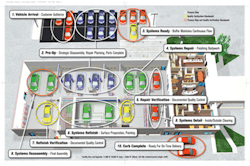DCR Systems – the business I started 11 years ago – was conceived and built around one simple objective: To completely dismantle the conventional collision repair business model and start thinking differently about every aspect of our operation in order to rebuild an environment that was process- centered and would alter the fundamentals that drive our industry.
That mentality – which presumes that "there has to be a better way" – has been at the forefront of our management thinking from day one, and continues to be prevalent today. And while we've struggled from time to time in many of our efforts to redefine different facets of the process, those speed bumps have ultimately steered us closer to achieving long-term success.
This calculated trial-and-error approach (commonly referred to as “continuous improvement” in lean-speak), when paired with an ever-changing marketplace, has led to some very important discoveries which we've incorporated into our management thinking and subsequent business model. But amid all of the changes we've experienced over the years, the one key aspect of our market which has remained relatively unchanged is the VALUE that the customer places on what we do.
In DCR's dealer-based collision repair world, our customer is the vehicle owner (but that doesn't mean other parties in the value equation aren'tjust as important.) Sure, you may operate as an independent shop, or part of an MSO, or even as a DRP-driven operation alongside an insurance provider, but if you don't regard the vehicle owner as your ultimate customer, then you're going to have trouble buying in to the rest of this article.
It's the vehicle owner whose expectations you have to meet the moment they pull into your lot. It's the vehicle owner who has to recall the sordid details of their loss that led them to your place of business. It's the vehicle owner who gives the thumbs-up (or thumbs-down) on your work. And it's the vehicle owner who will tell the rest of the world how good you are at your job, and how well you've met their expectations.
The vehicle owner has their own set of values when they come to your shop, and if your team is not in tune with those values, then no matter how good you are at what you do, you'll suffer in the long run.
Defining Customer Values
Rule #1 in the lean production world is to know, understand and respond to what your customers value and what they expect. Because if you and your team can't pinpoint those values, then it's like guiding a train up an unending mountainside; eventually you're going to run out of steam (and really disappoint your customer). So it's vitally important to define exactly what those customer values are, then work to develop a process that is centered on those values.
When was the last time you had a heart-to-heart discussion about customer value with your team? Developing a process that encompasses customer value begins with a dialog among your employees to first
define value so that everyone is on the same page, and then examining your entire production process to ensure that everything that you do is in line with that definition.
Through such discussion, you may discover that your staff may be so focused on their specific tasks, that they really don't have a clue of what the true customer value is. Or that there are inconsistent definitions of customer value running through the business. Or even that value normally takes a back seat to simply completing the job in a thorough and efficient manner.
A Simple Exercise to Determine Customer Value
Here's a huge question for you to ponder: If given the opportunity, how would your customers redesign your business? From the “Enter Here” sign in the parking lot, to the waiting room décor, to customer/vendor communications, right through to the delivery and key return process, what specific changes would your customers make to improve their collision repair experience to meet their specific values and expectations?
MARCH: That's an important question you need to pose to your team. And when they look at you in response with blank stares, then maybe it's time to invite some customers into the office and play out this scenario. Because if you and your team are trying to define value without getting your customers' input, then you're simply doing it wrong. Success depends on defining exactly what the customer wants, not what you think the customer wants.
If you can answer this question, then you're well on the path to operating a business model that is more customer-centric and less this-is-how-we've-always-done-it-centric. And you'll see your bottom line vastly improve.
What we've discovered in our journey to create the ultimate process-centered repair environment are two key values that our customers demand: Predictability and Dependability.
Customer Value #1: Predictability
Predictability simply ensures the customer that there will be no surprises when their vehicle is returned to them. It provides peace-of-mind that the customer's “pains” have been heard at the outset by the shop and that those pains will be rectified upon delivery. It reassures the customer that the greatest care will be taken in every step of the repair process to restore the vehicle to its original splendor. It guarantees that the vehicle will be delivered to the customer in the timeframe that was originally quoted.
Predictability begins at the initial diagnostic end of the process, and involves connecting with the customer on several due-diligence fronts, such as:
• Meeting with and listening to the customer to get them to talk about the circumstances that resulted in the loss (while recognizing their stress and confusion);
• Recording every detail of the incident to get a precise idea of the extent of the damage;
• Asking the right questions to assess any potential secondary damage: Was there a passenger in the vehicle (seat belt repair needed)? Any beverages in the cup holders (stain removal required)? Was the vehicle pushed into the curb (structural or mechanical alignment assessment)?
• Preparing voice recordings of specific or unique facts from the initial damage assessment. These digital recordings are included in the job jacket which will be reviewed by the Repair Planner.
It's these simple up-front steps (and many others) that not only will help you to accurately diagnose the damage, but will enable you to provide a realistic delivery date to the customer.
Predictability means no surprises. If you can provide a customer experience that doesn't include any surprises, then you've successfully connected with one of their core values.
Customer Value #2: Dependability
The customer's perception of dependability presumes that the product they receive for their money will be top-notch, without defects, delivered on time and 100% flawless. Period.
On paper, your production process may offer that level of accuracy. Our process-centered approach works perfectly on paper every single time. It's the execution of the process, without waste, that separates reality from what's on paper.
Where's the waste in your process? Is it waiting times? Rework (in its many forms)? Transporting, moving and identifying the vehicles on the lot? Is it searching for that missing clip in the assembly area? Is it matching color as the vehicle is in the paint booth awaiting paint?
All of these wastes add a little chink to your process and slowly begin to erode dependability.
Dependability relies heavily on standards and validation, which begins (again) with precise diagnosis and feeds into all other process areas, including:
• Strategic disassembly (versus a traditional tear-down) to touch and feel for accuracy;
• Utilizing technical support specific to that vehicle to ensure correct parts are ordered;
• Using an estimating database to identify accurate repair costs;
• Mirror-matching parts and repairing the vehicle according to manufacturer standards;
• Establishing quality verification checkpoints throughout the process, which audit everything from the initial repair plan and customer info to parts, cart setup, color matching and beyond.
Employing a team-approach to repair, which is fortified with ongoing "pitch meetings" or regular on-floor production sessions that constantly update team members while allowing them to point out bottlenecks, issues, inventory and other wasteful flaws in the process. The goal is to keep the process ever-moving (or 100% touch-time as we refer to it). If you can maintain a strong validation component throughout the process, you'll cut waste and move closer to dependability. Your customer seeks two simple core values when it comes to the quality and delivery of their vehicle, predictability and dependability. If you can operate a shop that focuses on and pursues these values, then you'll be providing a service that meets or exceeds expectations and thrills the customer.


